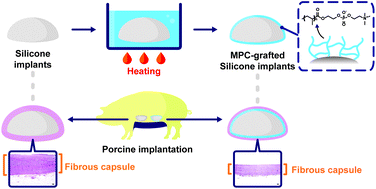当前位置:
X-MOL 学术
›
Biomater. Sci.
›
论文详情
Our official English website, www.x-mol.net, welcomes your feedback! (Note: you will need to create a separate account there.)
Efficient reduction of fibrous capsule formation around silicone breast implants densely grafted with 2-methacryloyloxyethyl phosphorylcholine (MPC) polymers by heat-induced polymerization.
Biomaterials Science ( IF 6.6 ) Pub Date : 2020-01-14 , DOI: 10.1039/c9bm01802f Sunah Kang 1 , Jungah Kim 1 , Seulah Kim 1 , Maierdanjiang Wufuer 2 , Sohyun Park 1 , Youngmin Kim 3 , Dongkil Choi 1 , Xian Jin 2 , Yumin Kim 1 , Yan Huang 3 , Byoungjun Jeon 4 , Tae Hyun Choi 5 , Ji-Ung Park 6 , Yan Lee 1
Biomaterials Science ( IF 6.6 ) Pub Date : 2020-01-14 , DOI: 10.1039/c9bm01802f Sunah Kang 1 , Jungah Kim 1 , Seulah Kim 1 , Maierdanjiang Wufuer 2 , Sohyun Park 1 , Youngmin Kim 3 , Dongkil Choi 1 , Xian Jin 2 , Yumin Kim 1 , Yan Huang 3 , Byoungjun Jeon 4 , Tae Hyun Choi 5 , Ji-Ung Park 6 , Yan Lee 1
Affiliation

|
Implants based on silicone elastomers, polydimethylsiloxane (PDMS), have been widely used for breast augmentation and reconstruction, but excessive foreign body reactions around implants often cause serious side effects such as capsular contracture. In our previous study, we covalently grafted 2-methacryloyloxyethyl phosphorylcholine (MPC)-based polymers on the surface of PDMS blocks by UV-induced polymerization and showed effective reduction of capsular formation around the MPC-grafted PDMS in rats. In the present study, we examined the efficacy of heat-induced polymerization of MPC grafting on silicone breast implants intended for humans, and analyzed the in vivo inhibitory effect against capsular formation and inflammation in pigs, which are closely related to humans in terms of epidermal structures and fibrotic processes. The heat-induced polymerization provided a thicker MPC-grafted surface and was more effective than UV-induced polymerization for the grafting of complex shaped non-transparent implants. After 24-week implantation in the submuscular pockets of Yorkshire pigs, the heat-induced MPC-grafted breast implants showed 45% smaller capsular thickness and 20-30% lower levels of inflammatory markers such as myeloperoxidase (MPO), transforming growth factor-β (TGF-β), and α-smooth muscle actin (α-SMA) in surrounding tissues compared to non-grafted implants. This study provides important information for future clinical trials of MPC-grafted silicone implants.
中文翻译:

通过热诱导聚合有效减少2-甲基丙烯酰氧基乙基磷酰胆碱(MPC)聚合物紧密接枝的硅树脂乳房植入物周围纤维囊的形成。
基于有机硅弹性体聚二甲基硅氧烷(PDMS)的植入物已被广泛用于隆胸和重建,但是植入物周围的过多异物反应通常会引起严重的副作用,例如囊膜挛缩。在我们之前的研究中,我们通过紫外线诱导的聚合将基于2-甲基丙烯酰氧基乙基磷酰胆碱(MPC)的聚合物共价接枝到PDMS嵌段的表面,并显示出有效减少了MPC接枝的PDMS大鼠周围荚膜的形成。在本研究中,我们研究了热诱导的MPC接枝聚合在针对人类的硅胶乳房植入物上的功效,并分析了对猪荚膜形成和炎症的体内抑制作用,这在表皮方面与人类密切相关结构和纤维化过程。热诱导的聚合反应提供了更厚的MPC接枝表面,并且比UV诱导的聚合反应更有效地移植了复杂形状的不透明植入物。在约克郡猪的肌下袋中植入24周后,热诱导的MPC移植的乳房植入物的荚膜厚度减小了45%,而髓过氧化物酶(MPO)等炎症标记物的水平降低了20-30%,从而转化了生长因子-β (TGF-β)和周围组织中的α-平滑肌肌动蛋白(α-SMA)与未移植的植入物相比。这项研究为MPC移植有机硅植入物的未来临床试验提供了重要信息。在约克郡猪的肌下袋中植入24周后,热诱导的MPC移植的乳房植入物的荚膜厚度减小了45%,而髓过氧化物酶(MPO)等炎症标记物的水平降低了20-30%,从而转化了生长因子-β (TGF-β)和周围组织中的α-平滑肌肌动蛋白(α-SMA)与未移植的植入物相比。这项研究为MPC移植有机硅植入物的未来临床试验提供了重要信息。在约克郡猪的肌下袋中植入24周后,热诱导的MPC移植的乳房植入物的荚膜厚度减小了45%,而髓过氧化物酶(MPO)等炎症标记物的水平降低了20-30%,从而转化了生长因子-β (TGF-β)和周围组织中的α-平滑肌肌动蛋白(α-SMA)与未移植的植入物相比。这项研究为MPC移植有机硅植入物的未来临床试验提供了重要信息。
更新日期:2020-03-19
中文翻译:

通过热诱导聚合有效减少2-甲基丙烯酰氧基乙基磷酰胆碱(MPC)聚合物紧密接枝的硅树脂乳房植入物周围纤维囊的形成。
基于有机硅弹性体聚二甲基硅氧烷(PDMS)的植入物已被广泛用于隆胸和重建,但是植入物周围的过多异物反应通常会引起严重的副作用,例如囊膜挛缩。在我们之前的研究中,我们通过紫外线诱导的聚合将基于2-甲基丙烯酰氧基乙基磷酰胆碱(MPC)的聚合物共价接枝到PDMS嵌段的表面,并显示出有效减少了MPC接枝的PDMS大鼠周围荚膜的形成。在本研究中,我们研究了热诱导的MPC接枝聚合在针对人类的硅胶乳房植入物上的功效,并分析了对猪荚膜形成和炎症的体内抑制作用,这在表皮方面与人类密切相关结构和纤维化过程。热诱导的聚合反应提供了更厚的MPC接枝表面,并且比UV诱导的聚合反应更有效地移植了复杂形状的不透明植入物。在约克郡猪的肌下袋中植入24周后,热诱导的MPC移植的乳房植入物的荚膜厚度减小了45%,而髓过氧化物酶(MPO)等炎症标记物的水平降低了20-30%,从而转化了生长因子-β (TGF-β)和周围组织中的α-平滑肌肌动蛋白(α-SMA)与未移植的植入物相比。这项研究为MPC移植有机硅植入物的未来临床试验提供了重要信息。在约克郡猪的肌下袋中植入24周后,热诱导的MPC移植的乳房植入物的荚膜厚度减小了45%,而髓过氧化物酶(MPO)等炎症标记物的水平降低了20-30%,从而转化了生长因子-β (TGF-β)和周围组织中的α-平滑肌肌动蛋白(α-SMA)与未移植的植入物相比。这项研究为MPC移植有机硅植入物的未来临床试验提供了重要信息。在约克郡猪的肌下袋中植入24周后,热诱导的MPC移植的乳房植入物的荚膜厚度减小了45%,而髓过氧化物酶(MPO)等炎症标记物的水平降低了20-30%,从而转化了生长因子-β (TGF-β)和周围组织中的α-平滑肌肌动蛋白(α-SMA)与未移植的植入物相比。这项研究为MPC移植有机硅植入物的未来临床试验提供了重要信息。



























 京公网安备 11010802027423号
京公网安备 11010802027423号